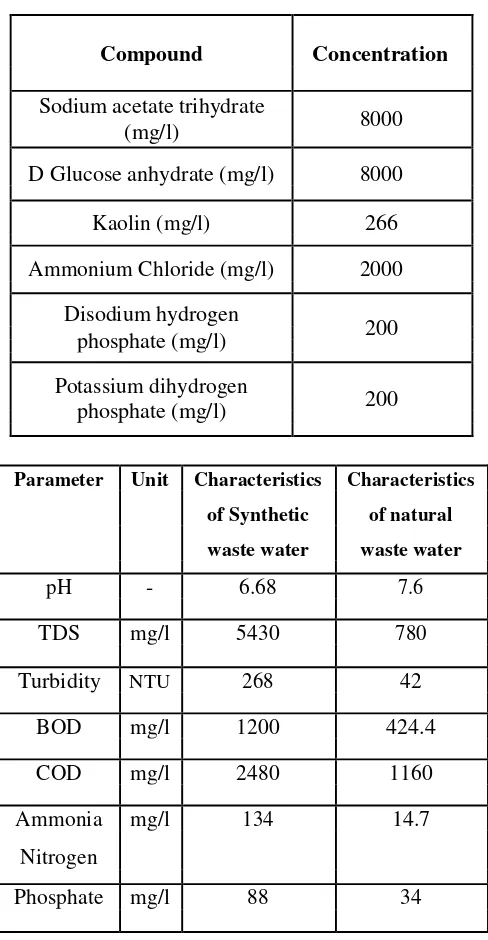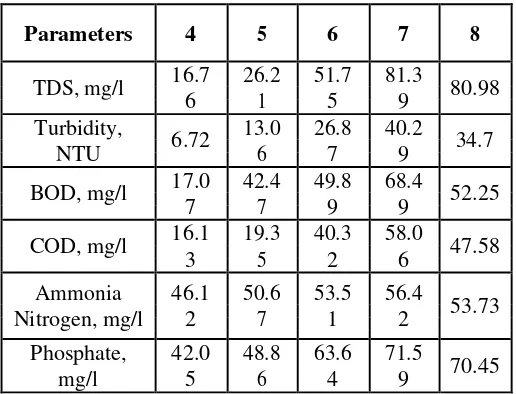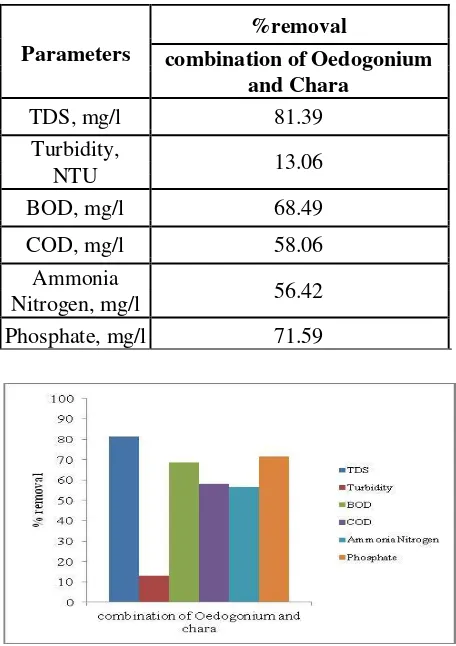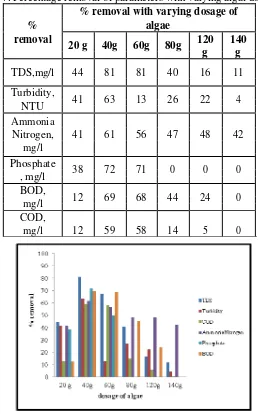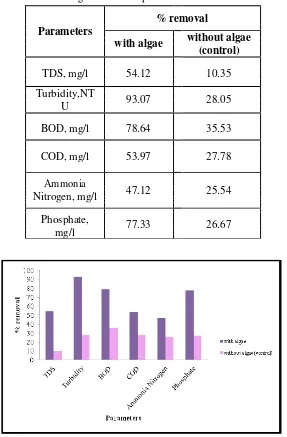ISSN (Online) : 2319 - 8753
ISSN (Print) : 2347 - 6710
I
nternationalJ
ournal ofI
nnovativeR
esearch inS
cience,E
ngineering andT
echnologyAn ISO 3297: 2007 Certified Organization, Volume 2, Special Issue 1, December 2013
Proceedings of International Conference on Energy and Environment-2013 (ICEE 2013)
On 12th to 14th December Organized by
Department of Civil Engineering and Mechanical Engineering of Rajiv Gandhi Institute of Technology, Kottayam, Kerala, India
WASTE WATER TREATMENT BY ALGAE
Arya Krishnan
, Anand Lali NeeraGovernment Engineering College, Thrissur, Kerala, India
Government Engineering College Thrissur,
Thrissur, Kerala, India
Abstract: As many research works are going on in the field of wastewater treatment, a newly developed wastewater treatment by algae is gainingmuch importance. The algae selected for the study was Oedogonium and Chara sp. Various parameters like Biological oxygen demand (BOD), Chemical oxygen demand (COD), Ammonia Nitrogen and Phosphate were observed after the treatment. Percentage reduction rate of 59.61(BOD), 53.97 (COD) were observed. This is an environmentally safe alternative for treating wastewater.
1.INTRODUCTION
Waste water treatment is gaining much importance in recent years with the intension of reusing it. For the treatment of wastewater large amount of materials are to be supplemented. Nutrient rich wastewater instead of discharging into environment is supplemented for the growth of algae in the wastewater treatment. Thus nutrients can be reused and wastewater can be treated and thus reducing the negative impacts. As the algae takes up N and P, the wastewater can be treated with algae. This paper explains wastewater treatment by macroalgal species.
2.Materials and methods
2.1. Selection of algae
2.2. Selection of wastewater
Wastewater choosen was rice mill wastewater which contains N and P. Experiments were performed under laboratory based batch conditions since algae shows high growth rates over the batch growth period. The rice mill wastewater was collected from Nambiyattukudy agro mills, Perumbavoor, Ernakulam. Synthetic wastewater whose characteristics were similar to rice mill wastewater was used in the study for optimizing the parameters[1]. The composition of this synthetic wastewater was given in Table 1. The optimum conditions obtained were applied for the treatment of natural wastewater. The characteristics of synthetic and natural ricemill wastewater was given in Table 2.
Table 1:-Composition of Synthetic wastewater
Compound Concentration
Sodium acetate trihydrate
8000 (mg/l)
D Glucose anhydrate (mg/l) 8000
Kaolin (mg/l) 266 Ammonium Chloride (mg/l) 2000
Disodium hydrogen
200 phosphate (mg/l)
Potassium dihydrogen
200 phosphate (mg/l)
Parameter Unit Characteristics Characteristics
of Synthetic of natural
waste water waste water
pH - 6.68 7.6 TDS mg/l 5430 780 Turbidity NTU 268 42
BOD mg/l 1200 424.4 COD mg/l 2480 1160 Ammonia mg/l 134 14.7
Nitrogen
Phosphate mg/l 88 34
Table 2:-Characteristics of wastewater
2.3 Procedure
were varied to find the optimum condition [2].
2.4. Optimization of number of days
The synthetic wastewater was fed to the reactor containing 60 g of each algae. No pH adjustment was made. Then at each day samples were collected and analysed for the various parameters like pH, TDS, Turbidity, BOD, COD, Ammonia Nitrogen and Phosphate.
2.5 Optimization of pH
After optimizing number of days, the pH of synthetic wastewater was varied. The synthetic wastewater with different pH was fed to the reactor with 60 g of each algae. The selected pH were 4, 5, 6, 7and 8. The samples collected after the optimized day were analysed for the various parameters.
2.6 Varying algal species
Oedogonium and Chara algae of 60 g each were taken separately for treating with synthetic wastewater. Combination of algal species of 60 g were also taken for the study simultaneously.
2.6.1 With aeration
After fixing optimum days and pH the synthetic wastewater was treated with Oedogonium and Chara algae separately of 60 g. Aeration of 9 l/min has been provided. The samples were analysed after treatment. The same has been repeated with the combination of algal species.
2.6.2 Without Aeration
After fixing optimum number of days and pH treatment of algae with synthetic wastewater has
been carried out without aeration. Here also combination of algal species has been taken for the
treatment. Similarly individual algal species also has been taken for the treatment [3]. Samples after treatment has been taken for the analysis of the parameters.
2.7 Varying algal dosage
The synthetic wastewater was treated with algal species of varying dosage after optimizing number of days and pH. Aeration has been provided.20, 40, 60, 80, 120 and 140g of each algal species were taken for the study. The samples collected after treatment were analysed for the various parameters.
3. Results and discussion
The treatment of synthetic rice mill wastewater with algae was studied with varying conditions and the optimum has been finalized for doing with natural wastewater. Performance of Oedogonium and Chara algae for the treatment of synthetic wastewater was first carried out.
Table 4. Percentage removal of different parameters with time (in days)
Parameters Time in DAYS
1st 2nd 3rd 4th 5th 6th 7th 8th 9th 10th
TDS,mg/l 20.63 22.65 29.48 18.42 26.7 28.55 74.22 42.91 42.36 42.08 Turbidity,NTU 6.34 14.55 19.03 20.89 25.37 37.31 39.93 22.39 21.64 16.79 BOD, mg/l 19.93 43.79 51.88 55.82 65.67 72.33 80.82 63.33 62.95 61.38 COD,mg/l 21.89 41.57 47.22 48.39 50 79.03 82.26 16.13 15.32 13.02
Ammonia
12.54 23.73 32.98 36.79 45.22 46.87 47.76 28.51 24.1 15.29 Nitrogen, mg/l
Figure 1. Percentage removal of parameters with time
As the number of days get increased the removal efficiency of various characteristics also get increased. At seventh day the removal of TDS, Turbidity, COD, BOD and Ammonia Nitrogen was found to be maximum. But with Phosphate maximum removal was found to be at the sixth day. BOD removal of 80.82%, COD of 82.26%, TDS of 74.22%, Ammonia Nitrogen of 47.76%, Turbidity of 39.93% was obtained at the seventh day whereas 100% removal of Phosphate was obtained at the sixth day and as the days goes on increasing, the removal capacity of algae decreases. After 7th day algae degradation starts and it may have caused a decrease in the removal rate.
Table 5. Variation of different parameters with different pH
Parameters 4 5 6 7 8
TDS, mg/l 16.7 26.2 51.7 81.3 80.98 6 1 5 9
Turbidity,
6.72 13.0 26.8 40.2 34.7 NTU 6 7 9
BOD, mg/l 17.0 42.4 49.8 68.4 52.25 7 7 9 9
COD, mg/l 16.1 19.3 40.3 58.0 47.58 3 5 2 6
Ammonia 46.1 50.6 53.5 56.4
53.73 Nitrogen, mg/l 2 7 1 2
Phosphate, 42.0 48.8 63.6 71.5
Figure 2. Variation of different parameters with different pH
As pH changed from acidic to alkaline the removal efficiency got increased and maximum removal has been obtained at pH 7. Afterwards, as the pH was again made alkaline,i.e at pH 8, there was not much increase in the removal rate and a slight decrease in the values has been found. Most of the biological reactions occur at neutral pH [5] and the algae grown water also shows pH 6.8 and it was the condition prevailing for the better growth of algae.
Table 6. Percentage removal of parameters with combination of algal species and with aeration
%removal
Parameters combination of Oedogonium and Chara
TDS, mg/l 81.39 Turbidity,
13.06 NTU
BOD, mg/l 68.49 COD, mg/l 58.06
Ammonia
56.42 Nitrogen, mg/l
Phosphate, mg/l 71.59
Percentage removal of 81.39% TDS, 71.59 % Phosphate, 68.49 %BOD, 58.06% COD, 56.42% Ammonia Nitrogen, 13.06% Turbidity were obtained. Since algae is an aerobic organism and require oxygen for their survival and additional aeration rate of 9 l/min will remove parameters from wastewater than without providing aeration [4]. In anaerobic conditions it cannot survive.
Table 7. Percentage removal of parameters with varying algal dosage
% removal with varying dosage of
% algae
removal
20 g 40g 60g 80g 120 140
g g
TDS,mg/l 44 81 81 40 16 11 Turbidity,
41 63 13 26 22 4 NTU
Ammonia
Nitrogen, 41 61 56 47 48 42 mg/l
Phosphate
38 72 71 0 0 0 , mg/l
BOD,
12 69 68 44 24 0 mg/l
COD,
12 59 58 14 5 0 mg/l
Figure 4. Percentage removal of parameters with varying algal dosage
4. NATURAL WASTEWATER TREATMENT
Table 8. Percentage removal of parameters in natural wastewater
% removal Parameters
with algae without algae (control)
TDS, mg/l 54.12 10.35 Turbidity,NT
93.07 28.05 U
BOD, mg/l 78.64 35.53
COD, mg/l 53.97 27.78
Ammonia
47.12 25.54 Nitrogen, mg/l
Phosphate, 77.33 26.67 mg/l
Figure 5.Percentage removal of parameters in natural wastewater
Total volume of 5 litres of natural ricemill wastewater taken under optimum conditions of retention time 7 days, pH 7, combination of algae with aeration, 40 g algal dosage shows removal of 54.12% TDS, 93.07%Turbidity, 78.64% BOD, 53.97% COD, 47.12% Ammonia Nitrogen, 77.33% Phosphate.
5. CONCLUSION
obtained. Since some of the parameters are not within the limit, post treatment has to be provided.
REFERENCES
[1] Deviram GVNS et al. ‟Purification of wastewater Using algal species”. European Journal of Experimental Biology, 1(3):216-222,
2011.
[2] Karin Larsdotter. “Wastewater treatment with microalgae”. Vatten 62:31-38, 2006.
[3] J.B.K. Park et al. Bioresource Technology 102: 35- 42, 2011.
[3] Hong-Ying HU et al. “Domestic wastewater reclamation coupled with Biofuel: A Novel wastewater treatment process in the
future”.Journal of Water and Environment Technology, 9(2), 2011.
[4] Monica C.Rothermel.”Coupling the wastewater treatment process with an algal photobioreactor for nutrient removal and renewable
